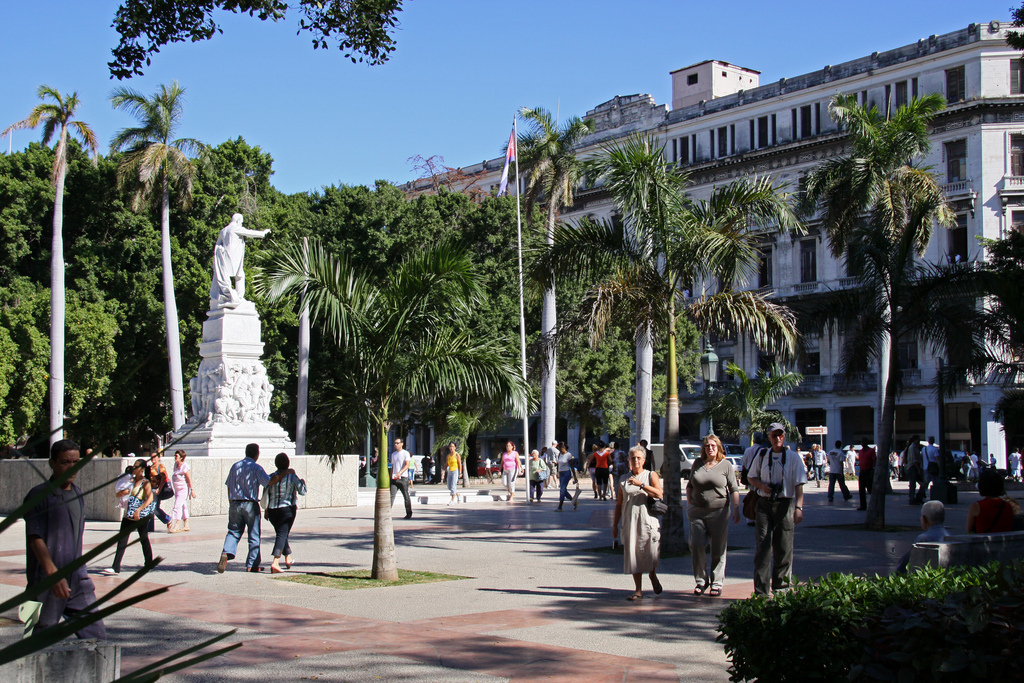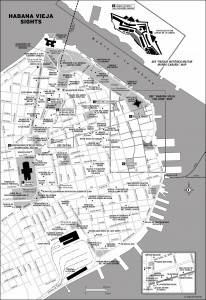
Parque Central in Habana Vieja. Photo © Tony Hisgett, licensed Creative Commons Attribution.
Spacious Parque Central is the social epicenter of Habana Vieja. The park—bounded by the Prado, Neptuno, Zulueta, and San Martín—is presided over by stately royal palms shading a marble statue of José Martí. Erected on the 10th anniversary of the national hero’s death, it was sculpted by José Vilalta de Saavedra and inaugurated in 1905. Baseball fanatics gather at a point called esquina caliente (“hot corner”) to discuss and argue the intricacies of pelota (baseball).The park is surrounded by historic hotels, including the triangular Hotel Plaza (Zulueta #267), built in 1909, on the northeast face of the square. In 1920, Babe Ruth stayed in room 216, preserved as a museum with his signed bat and ball in a case.

Habana Vieja Sights
Much of the social action happens in front of the Hotel Inglaterra (Paseo de Martí #416), opened in 1856 and today the oldest Cuban hotel still extant. The sidewalk Café Louvre, known in colonial days as the Acera del Louvre, was a focal point for rebellion against Spanish rule. A plaque outside the hotel entrance honors the “lads of the Louvre sidewalk” who died for Cuban independence.
Inside, the hotel boasts elaborate wrought-ironwork and exquisite Mudejar-style detailing, including arabesque archways and azulejos (patterned tile). A highlight is the sensuous life-size bronze statue of a Spanish dancer—La Sevillana—in the main bar.
Immediately south of the Inglaterra, the Gran Teatro (Paseo de Martí #452, e/ San Rafael y Neptuno, tel. 07/861-3077, daily 9 a.m.–5 p.m., CUC2 with guided tour) originated in 1837 as the Teatro Tacón, drawing operatic luminaries such as Enrico Caruso and Sarah Bernhardt. The current neo-baroque structure dates from 1915, when a social club—the Centro Gallego—was built around the old Teatro Tacón for the Galician community.
Its exorbitantly baroque facade drips with caryatids and has four towers, each tipped by a white marble angel reaching gracefully for heaven. The entire edifice is crumbling dangerously, however, though it still functions as a theater for the Ballet Nacional and Opera Nacional de Cuba. The main auditorium—the exquisitely decorated 2,000-seat Teatro García Lorca—features a painted dome and huge chandelier. Smaller performances are hosted in the 500-seat Sala Alejo Carpentier and the 120-seat Sala Artaud.
Artes (International Section) The international section of the Museo Nacional de Bellas Artes (National Fine Arts Museum, San Rafael, e/ Zulueta y Monserrate, tel. 07/863-9484 or 862-0140, Tues.–Sat. 10 a.m.–6 p.m., Sun. 10 a.m.–2 p.m., entrance CUC5, or CUC8 for both sections, guided tour CUC2) occupies the Centro Asturiano, on the southeast side of the square. The building, lavishly decorated with neoclassical motifs, was erected in 1885 but rebuilt in Renaissance style in 1927 following a fire and until recently housed the post-revolutionary People’s Supreme Court. A highlight is the stained-glass window above the main staircase showing Columbus’s three caravels.
The art collection is displayed on five floors covering 4,800 square meters. The works are separated by nationality and span the United States, Latin America, Asia, and Europe— including masters such as Gainsborough, Goya, Murillo, Rubens, Velásquez, and various Impressionists. The museum also boasts Latin America’s richest trove of Roman, Greek, and Egyptian antiquities.
A 248-seat theater hosts cultural activities.
The statuesque Capitolio (Capitol, Paseo de Martí, e/ San Martín y Dragones, tel. 07/861- 5519, daily 9 a.m.–7 p.m., entrance CUC3, guided tours CUC1, cameras CUC2), one block south of Parque Central, dominates Havana’s skyline. It was built between 1926 and 1929 as Cuba’s Chamber of Representatives and Senate and designed after Washington’s own Congress building. The 692-foot-long edifice is supported by flanking colonnades of Doric columns, with semicircular pavilions at each end of the building. The lofty stone cupola rises 61.75 meters, topped by a replica of 16th-century Florentine sculptor Giambologna’s famous bronze Mercury in the Palazzo de Bargello.
A massive stairway—flanked by neoclassical figures in bronze by Italian sculptor Angelo Zanelli that represent Labor and Virtue—leads up to an entrance portico with three tall bronze doors sculpted with 30 bas-reliefs that depict important events of Cuban history. Inside, facing the door is the Estatua de la República (Statue of the Republic), a massive bronze sculpture (also by Zanelli) of Cuba’s voluptuous Indian maiden. At 17.54 meters (56 feet) tall, she is the world’s third-largest indoor statue (the other two are the gold Buddha in Nava, Japan, and the Lincoln Memorial in Washington, D.C.). In the center of the floor is a 24-carat diamond replica that marks Kilometer 0, the point from which all distances on the island are calculated (rumor has it that the original is kept in Fidel’s office). Above, the gilt-covered dome has a barrel-vaulted ceiling carved in refulgent relief.
The 394-foot-long Salón de los Pasos Perdidos (Great Hall of the Lost Steps), so named because of its acoustics, is inlaid with patterned marble motifs and features bronze bas-reliefs, green marble pilasters, and massive lamps on carved pedestals of glittering copper. Renaissance-style candelabras dangle from the frescoed ceiling. The semicircular Senate chamber and Chamber of Representatives are at each end; former congressional offices line the hallway, and there’s a mahogany-paneled former congressional library.
The Capitolio is the headquarters of the Academía de Ciencias (Academy of Sciences); the library—the Biblioteca Nacional de Ciencias y Naturales—is on the Capitolio’s south side (Mon.–Sat. 8 a.m.–5 p.m.).
Excerpted from the Fifth Edition of Moon Cuba.